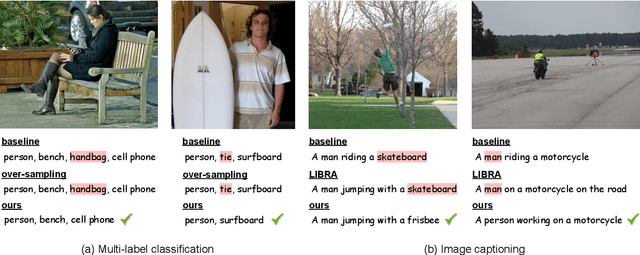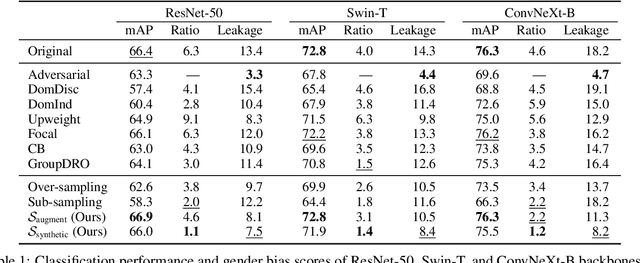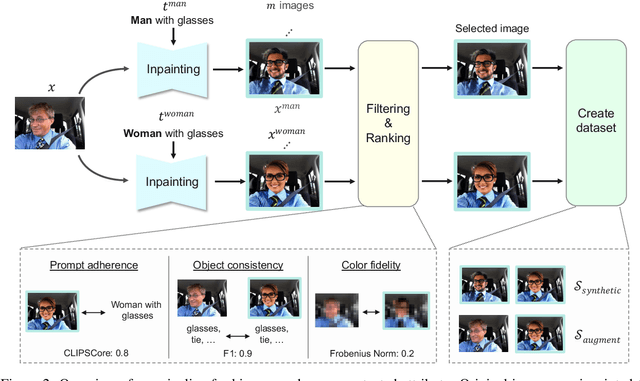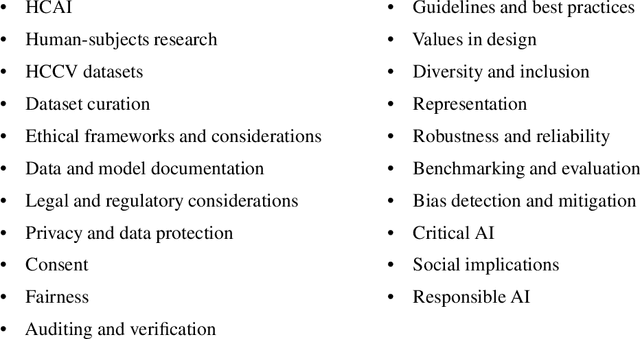Alice Xiang
Shammie
Efficient Bias Mitigation Without Privileged Information
Sep 26, 2024Abstract:Deep neural networks trained via empirical risk minimisation often exhibit significant performance disparities across groups, particularly when group and task labels are spuriously correlated (e.g., "grassy background" and "cows"). Existing bias mitigation methods that aim to address this issue often either rely on group labels for training or validation, or require an extensive hyperparameter search. Such data and computational requirements hinder the practical deployment of these methods, especially when datasets are too large to be group-annotated, computational resources are limited, and models are trained through already complex pipelines. In this paper, we propose Targeted Augmentations for Bias Mitigation (TAB), a simple hyperparameter-free framework that leverages the entire training history of a helper model to identify spurious samples, and generate a group-balanced training set from which a robust model can be trained. We show that TAB improves worst-group performance without any group information or model selection, outperforming existing methods while maintaining overall accuracy.
Position: Measure Dataset Diversity, Don't Just Claim It
Jul 11, 2024Abstract:Machine learning (ML) datasets, often perceived as neutral, inherently encapsulate abstract and disputed social constructs. Dataset curators frequently employ value-laden terms such as diversity, bias, and quality to characterize datasets. Despite their prevalence, these terms lack clear definitions and validation. Our research explores the implications of this issue by analyzing "diversity" across 135 image and text datasets. Drawing from social sciences, we apply principles from measurement theory to identify considerations and offer recommendations for conceptualizing, operationalizing, and evaluating diversity in datasets. Our findings have broader implications for ML research, advocating for a more nuanced and precise approach to handling value-laden properties in dataset construction.
Resampled Datasets Are Not Enough: Mitigating Societal Bias Beyond Single Attributes
Jul 04, 2024



Abstract:We tackle societal bias in image-text datasets by removing spurious correlations between protected groups and image attributes. Traditional methods only target labeled attributes, ignoring biases from unlabeled ones. Using text-guided inpainting models, our approach ensures protected group independence from all attributes and mitigates inpainting biases through data filtering. Evaluations on multi-label image classification and image captioning tasks show our method effectively reduces bias without compromising performance across various models.
A Taxonomy of Challenges to Curating Fair Datasets
Jun 10, 2024Abstract:Despite extensive efforts to create fairer machine learning (ML) datasets, there remains a limited understanding of the practical aspects of dataset curation. Drawing from interviews with 30 ML dataset curators, we present a comprehensive taxonomy of the challenges and trade-offs encountered throughout the dataset curation lifecycle. Our findings underscore overarching issues within the broader fairness landscape that impact data curation. We conclude with recommendations aimed at fostering systemic changes to better facilitate fair dataset curation practices.
Not My Voice! A Taxonomy of Ethical and Safety Harms of Speech Generators
Jan 25, 2024



Abstract:The rapid and wide-scale adoption of AI to generate human speech poses a range of significant ethical and safety risks to society that need to be addressed. For example, a growing number of speech generation incidents are associated with swatting attacks in the United States, where anonymous perpetrators create synthetic voices that call police officers to close down schools and hospitals, or to violently gain access to innocent citizens' homes. Incidents like this demonstrate that multimodal generative AI risks and harms do not exist in isolation, but arise from the interactions of multiple stakeholders and technical AI systems. In this paper we analyse speech generation incidents to study how patterns of specific harms arise. We find that specific harms can be categorised according to the exposure of affected individuals, that is to say whether they are a subject of, interact with, suffer due to, or are excluded from speech generation systems. Similarly, specific harms are also a consequence of the motives of the creators and deployers of the systems. Based on these insights we propose a conceptual framework for modelling pathways to ethical and safety harms of AI, which we use to develop a taxonomy of harms of speech generators. Our relational approach captures the complexity of risks and harms in sociotechnical AI systems, and yields an extensible taxonomy that can support appropriate policy interventions and decision making for responsible multimodal model development and release of speech generators.
Beyond Skin Tone: A Multidimensional Measure of Apparent Skin Color
Sep 10, 2023Abstract:This paper strives to measure apparent skin color in computer vision, beyond a unidimensional scale on skin tone. In their seminal paper Gender Shades, Buolamwini and Gebru have shown how gender classification systems can be biased against women with darker skin tones. Subsequently, fairness researchers and practitioners have adopted the Fitzpatrick skin type classification as a common measure to assess skin color bias in computer vision systems. While effective, the Fitzpatrick scale only focuses on the skin tone ranging from light to dark. Towards a more comprehensive measure of skin color, we introduce the hue angle ranging from red to yellow. When applied to images, the hue dimension reveals additional biases related to skin color in both computer vision datasets and models. We then recommend multidimensional skin color scales, relying on both skin tone and hue, for fairness assessments.
Flickr Africa: Examining Geo-Diversity in Large-Scale, Human-Centric Visual Data
Aug 16, 2023Abstract:Biases in large-scale image datasets are known to influence the performance of computer vision models as a function of geographic context. To investigate the limitations of standard Internet data collection methods in low- and middle-income countries, we analyze human-centric image geo-diversity on a massive scale using geotagged Flickr images associated with each nation in Africa. We report the quantity and content of available data with comparisons to population-matched nations in Europe as well as the distribution of data according to fine-grained intra-national wealth estimates. Temporal analyses are performed at two-year intervals to expose emerging data trends. Furthermore, we present findings for an ``othering'' phenomenon as evidenced by a substantial number of images from Africa being taken by non-local photographers. The results of our study suggest that further work is required to capture image data representative of African people and their environments and, ultimately, to improve the applicability of computer vision models in a global context.
Considerations for Ethical Speech Recognition Datasets
May 03, 2023Abstract:Speech AI Technologies are largely trained on publicly available datasets or by the massive web-crawling of speech. In both cases, data acquisition focuses on minimizing collection effort, without necessarily taking the data subjects' protection or user needs into consideration. This results to models that are not robust when used on users who deviate from the dominant demographics in the training set, discriminating individuals having different dialects, accents, speaking styles, and disfluencies. In this talk, we use automatic speech recognition as a case study and examine the properties that ethical speech datasets should possess towards responsible AI applications. We showcase diversity issues, inclusion practices, and necessary considerations that can improve trained models, while facilitating model explainability and protecting users and data subjects. We argue for the legal & privacy protection of data subjects, targeted data sampling corresponding to user demographics & needs, appropriate meta data that ensure explainability & accountability in cases of model failure, and the sociotechnical \& situated model design. We hope this talk can inspire researchers \& practitioners to design and use more human-centric datasets in speech technologies and other domains, in ways that empower and respect users, while improving machine learning models' robustness and utility.
A View From Somewhere: Human-Centric Face Representations
Mar 30, 2023



Abstract:Few datasets contain self-identified sensitive attributes, inferring attributes risks introducing additional biases, and collecting attributes can carry legal risks. Besides, categorical labels can fail to reflect the continuous nature of human phenotypic diversity, making it difficult to compare the similarity between same-labeled faces. To address these issues, we present A View From Somewhere (AVFS) -- a dataset of 638,180 human judgments of face similarity. We demonstrate the utility of AVFS for learning a continuous, low-dimensional embedding space aligned with human perception. Our embedding space, induced under a novel conditional framework, not only enables the accurate prediction of face similarity, but also provides a human-interpretable decomposition of the dimensions used in the human-decision making process, and the importance distinct annotators place on each dimension. We additionally show the practicality of the dimensions for collecting continuous attributes, performing classification, and comparing dataset attribute disparities.
Ethical Considerations for Collecting Human-Centric Image Datasets
Feb 07, 2023
Abstract:Human-centric image datasets are critical to the development of computer vision technologies. However, recent investigations have foregrounded significant ethical issues related to privacy and bias, which have resulted in the complete retraction, or modification, of several prominent datasets. Recent works have tried to reverse this trend, for example, by proposing analytical frameworks for ethically evaluating datasets, the standardization of dataset documentation and curation practices, privacy preservation methodologies, as well as tools for surfacing and mitigating representational biases. Little attention, however, has been paid to the realities of operationalizing ethical data collection. To fill this gap, we present a set of key ethical considerations and practical recommendations for collecting more ethically-minded human-centric image data. Our research directly addresses issues of privacy and bias by contributing to the research community best practices for ethical data collection, covering purpose, privacy and consent, as well as diversity. We motivate each consideration by drawing on lessons from current practices, dataset withdrawals and audits, and analytical ethical frameworks. Our research is intended to augment recent scholarship, representing an important step toward more responsible data curation practices.
 Add to Chrome
Add to Chrome Add to Firefox
Add to Firefox Add to Edge
Add to Edge